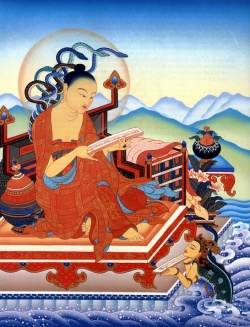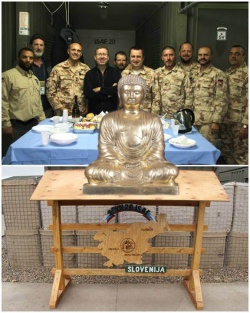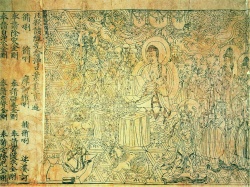The Great Madhyamaka
An introduction to the Cycle of Texts belonging to the Madhyamaka Empty-of-Other System
by Lama Jampa Thaye
Many great Kagyu masters have declared that the most profound view of the nature of reality is that set forth in the system of ‘The Great Madhyamaka’ or as it is often termed ‘The Madhyamaka Empty-of-Other’. According to these masters the Madhyamaka philosophical school can be divided into two principal lines: that of the ordinary Madhyamaka of the philosophers which asserts the essencelessness of all phenomena to be the highest view, and that of the extra-ordinary Madhyamaka of yogic practitioners which asserts that emptiness is not a mere negation but the inseparable union of awareness and the expanse of reality, a union that is primordially endowed with the qualities of Buddhahood and empty of any defiling elements. It is this latter line of Madhyamaka which in Tibet was termed ‘The Great Madhyamaka’ or ‘The Madhyamaka Empty-of-Other’. This term (Umé Zhentong) was used in opposition to the other sub-school which was termed ‘The Madhyamaka of Intrinsic Emptiness’ (Umé Rangtong). This ‘Madhyamaka of Intrinsic Emptiness’ included subdivisions of Madhyamaka which had developed in India through the work of such masters as Bhavya, Buddhapalita and Candrakirti.
The History of the Teaching – India
The source of the ‘The Great Madhyamaka’ or ‘The Madhyamaka Empty-of-Other’ is Lord Buddha’s teaching contained in the collection of sutras known as the sutras ‘of the essential meaning’ such as the Srimaladevi and Dharanisvara sutras which derive from the period of His teaching known as ‘The third Turning of the Wheel’. This teaching was further elaborated by the bodhisattva Maitreya, regent of the Buddha. Subsequently in the second century C.E. the acarya Nagarjuna wrote two short works including ‘The Praise of the Dharmadhatu’ to explicate this ‘Madhyamaka Empty-of-Other’ viewpoint. The siddhas Saraha and Sabara later blended these teachings with Vajrayana instructions and transmitted this synthesis through the medium of their Vajra-songs which were in turn received and transmitted by Maitripa (1007−), one of the two principal gurus of Marpa Lotsawa (1012−1097).
In the fourth century C.E. the master Asanga received direct transmission of the ‘Empty-of-Other’ teachings from the bodhisattva Maitreya in Tusita; in fact at that time Asanga received five textual teachings known as ‘The Five Dharmas of Maitreya’. It was the last two of these works, the Dharmadharmadatavibhanga and the Uttaratantrasastra, that were most explicit in presenting the ‘Empty-of-Other’ view.
Although Asanga and his half-brother Vasubhandu taught the philosophical view of the Cittamatra school to their ordinary followers, to their most advanced disciples they presented the ‘Five Dharmas’ and the ‘Empty-of-Other’ view. In the course of time however these inner teachings declined and it was only after several centuries that they were re-promulgated through the siddha Maitripa who received the reading transmissions of the Uttaratantrasastra and the Dharmadharmadatavibhanga from Maitreya himself. Maitripa then transmitted them to his Kashmiri disciple Anandakirti, who in turn gave them to Sajjana.
The History of the Teaching – Tibet
The earliest transmission of what would later be known as ‘The Great Madhyamaka’ or ‘Madhyamaka Empty-of-Other’ to Tibet occurred in the eighth century C.E. during the early diffusion of Buddhism in that country. At that time it appears that the ‘Five Dharmas of Maitreya’ were translated and the teaching then transmitted in tandem with the Mind section of Dzok Chen to which it bore a great similarity. This transmission later reached the omniscient Longchen Rabjam (1308−1363).
In the eleventh century, the period of the so-called ‘later diffusion’ of Buddhism in Tibet, there was a new translation of the ‘Five Dharmas of Maitreya’ by Ngok Loden Sherab. However this established only an explanatory not a meditative tradition of the teaching and therefore was not part of the ‘Great Madhyamaka’. Indeed the followers of this ‘explanatory’ tradition attempted to classify ’The Five Dharmas’ as belonging either to the Cittamatra or philosophical Madhyamaka schools and when ‘The Great Madhyamaka’ or ‘Empty-of-Other’ view flourished, criticised it severely.
It was the master Tsen Khawoche who having received the transmission from the Kashmiri pandita Sajjana spread the meditative tradition of Maitreya’s Dharmas in Tibet and with it the ‘The Great Madhyamaka’. Early masters in this line included Tsang-nag-pa Rigpé Sengge and Yumo (Yolmo) Mikyo Dorje. In fact it was one of the spiritual descendants of the latter, Dolpopa Sherab Gyaltsen(1292−1361), a member of the Jonangpa school, who established the terminology of the ‘The Madhyamaka Empty-of-Other’.
Other great masters who spread this teaching include Taranatha (1575−) also of the Jonangpa school and Shakya Chogden (1428−1507), the only Sakya scholar of note to accept it. In the Karma-Kagyu school Karmapa Rangjung Dorje (1284−1339), Karmapa Mikyo Dorje (1508−1554), the first Karmapa Thinley (1456−1540), Situ Tenpé Nyinche (1700−1774) and Jamgon Kongtrul Lodro Thaye (1813−1899) strove extensively to promulgate this teaching.
Key Works of the Empty-of-Other Cycle
The three principal works of this cycle in the Karma Kagyu tradition are ’Discriminating between ‘Consciousness and Primordial Wisdom’ and ‘Showing the Buddha-Nature’ both by Karmapa Rangjung Dorje’, and ‘The Correct Analysis of the Madhyamaka Empty-of-Other System]]’ by Karmapa Mikyo Dorje.
’Discriminating between Consciousness and Primordial Wisdom’
In this text Rangjung Dorje shows how this primordially pure basis or buddha-nature, when clouded by the ignorance of deluded consciousness, acts as the ground of samsara and, when that deluded consciousness is transformed into wisdom, as the basis of nirvana. In the first half of the text there is an examination of and refutation of a variety of tenets from the perspective of Madhyamaka, which is followed by a detailed investigation of the eight levels of consciousness which comprise samsaric mind. In the second part of the text Rangjung Dorje explains the methods and results of transformation of these defiled states into enlightened wisdom. Thus it is an essential text, first for philosophical insight but also as an explanation of the principles of spiritual practice. There are two main commentaries on this text, one authored by Jamgon Kontrul Lodro Thaye and a recent one composed by my guru Karma Thinley Rinpoche, entitled ‘The Lamp Dispelling Darkness’.
‘Showing the Buddha-Nature’
In this text Rangjung Dorje, following the teachings of the sutras and tantras, delineates the primordially pure buddha-nature which is unchanging throughout the three phases of basis, path and fruit. Although this buddha-essence is obscured by samsaric impurities, its intrinsic purity is never diminished. Thus the path of spiritual practice consists of removing these adventitious defilements from the gold of buddha-nature which when freed comprises buddhahood itself. The major commentary on this text is ‘Clarifying the Thought of Rang-jung’ by Jamgon Kongtrul Lodro Thaye.
‘The Correct Analysis of the Madhyamaka Empty-of-Other System’
In this text Karmapa Mikyo Dorje, one of the greatest scholars in the line of Karmapas, offers a profound defence of the Great Madhyamaka system. His work falls into five principal points:
(1) the reasoning that establishes the reality of buddha-nature,
(2) the essence of buddha-nature,
(3) the path that delivers buddha-nature from the stains,
(4) showing through examples how the buddha-nature is temporarily obscured by stains, and
(5) outlining the necessity for teaching the doctrine of buddha-nature.
Apart from these three texts there are other influential Karma-Kagyu presentations of this view such as those found in Jamgon Kongtrul’s ‘Lion’s Roar’, a commentary upon the Uttaratantrasastra and the same author’s ‘Instructions in the View of Empty-of-Other’ but these may be studied separately from this present cycle.
I have written this short account of the history of the Great Madhyamaka in accordance with the explanations of Karma Thinley Rinpoche from whom I received the transmission of the entire cycle and to whom I promised that I would uphold the ‘Madhyamaka Empty-of-Other’ view among Kagyupas.
Lama Jampa Thaye
Mahakala day
1st December 1994




